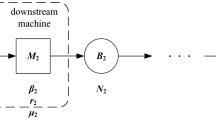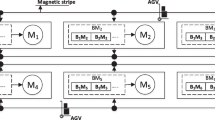Abstract
The buffer allocation problem is of particular interest for operations management since buffers have a considerable impact on capacity improvement in production systems. In this study, the buffer allocation is solved to optimize two conflicting objectives of maximizing the average system production rate and minimizing total buffer size. A hybrid evolutionary algorithm-based simulation optimization approach is proposed for the multi-objective buffer allocation problem (MOBAP) in open serial production lines. As a search methodology, the Pareto optimal set is derived by hybrid approach using elitist non-dominated sorting genetic algorithm (NSGA-II) and a special version of a multi-objective simulated annealing. As an evaluative tool, discrete event simulation modeling is used to estimate the performance measures for the production systems. To demonstrate the efficacy of the proposed hybrid approach, a comparative study is provided for the MOBAP in various serial line configurations. The comparative results show that the hybrid method has a considerable potential to minimize the total buffer space by appropriately allocating space to each buffer while maximizing average production rate.



(Reproduced with permission from Deb et al. 2002)







Similar content being viewed by others
References
Abdul-Kader, W., Ganjavi, O., & Baki, F. (2011). A nonlinear model for optimizing the performance of a multi-product production line. International Transactions in Operational Research,18(5), 561–577.
Amiri, M., & Mohtashami, A. (2012). Buffer allocation in unreliable production lines based on design of experiments, simulation, and genetic algorithm. International Journal of Advanced Manufacturing,62, 371–383.
Bandyopadhyay, S., & Bhattacharya, R. (2013). Applying modified NSGA-II for bi-objective supply chain problem. Journal of Intelligent Manufacturing,24(4), 707–716.
Bandyopadhyay, S., & Bhattacharya, R. (2014). Solving a tri-objective supply chain problem with modified NSGA-II algorithm. Journal of Manufacturing Systems,33, 41–50.
Baños, R., Ortega, J., Gil, C., Fernández, A., & Toro, F. (2013). A simulated annealing-based parallel multi-objective approach to vehicle routing problems with time windows. Expert Systems with Applications,40(5), 1696–1707.
Bekker, J. (2013). Multi-objective buffer space allocation with the cross-entropy method. International Journal of Simulation Modelling,12(1), 50–61.
Buzacott, J. A. (1967). Automatic transfer lines with buffer stocks. International Journal of Production Research,5(3), 183–200.
Buzacott, J. A., & Hanifin, L. E. (1978). Models of automatic transfer lines with inventory banks: A review and comparison. AIIE Transactions,10(2), 197–207.
Cakir, B., Altiparmak, F., & Dengiz, B. (2011). Multi-objective optimization of a stochastic assembly line balancing: A hybrid simulated annealing algorithm. Computers & Industrial Engineering,60(3), 376–384.
Chaube, A., Benyoucef, L., & Tiwari, M. K. (2012). An adapted NSGA-2 algorithm based dynamic process plan generation for a reconfigurable manufacturing system. Journal of Intelligent Manufacturing,23(4), 1141–1155.
Chehade, H., Yalaoui, F., Amodeo, L., & Dugardin, F. (2010). Buffers sizing in assembly lines using a Lorenz multiobjective ant colony optimization algorithm. In IEEE international conference on machine and web intelligence (pp. 283–287).
Cruz, F. R. B., Kendall, G., While, L., Duarte, A. R., & Brito, N. L. C. (2012). Throughput maximization of queueing networks with simultaneous minimization of service rates and buffers. Mathematical Problems in Engineering,2012, 1–19.
Cruz, F. R. B., Van Woensel, T., & Smith, J. M. (2010). Buffer and throughput trade-offs in M/G/1/K queuing networks: A bicriteria approach. International Journal of Production Economics,125, 224–234.
Dallery, Y., & Gershwin, S. B. (1992). Manufacturing flow line systems: A review of models and analytical results. Queuing Systems Theory and Applications (Special Issue on Queuing Model of Manufacturing Systems),12, 3–94.
De, A., Choudhary, A., & Tiwari, M. K. (2017). Multiobjective approach for sustainable ship routing and scheduling with draft restrictions. IEEE Transactions on Engineering Management,99, 1–17.
Deb, K., & Agrawal, R. B. (1995). Simulated binary crossover for continuous search space. Complex Systems,9, 115–148.
Deb, K., Agrawal, S., Pratab, A., & Meyarivan, T. (2002). A fast and elitist multiobjective genetic algorithm: NSGA-II. IEEE Transactions on Evolutionary Computation,6(2), 182–197.
Demir, L., Tunali, S., & Eliiyi, D. T. (2014). The state of the art on buffer allocation problem: A comprehensive survey. Journal of Intelligent Manufacturing,25(3), 371–392.
Ding, K., Jiang, P., & Zheng, M. (2017). Environmental and economic sustainability-aware resource service scheduling for industrial product service systems. Journal of Intelligent Manufacturing,28, 1303–1316.
Dolgui, A., Eremeev, A., Kolokolov, A., & Sigaev, V. (2002). A genetic algorithm for the allocation of buffer storage capacities in a production line with unreliable machines. Journal of Mathematical Modelling and Algorithms,1, 89–104.
Dolgui, A., Eremeev, A., Kovalyov, M. Y., & Sigaev, V. (2013). Complexity of buffer capacity allocation problems for production lines with unreliable machines. Journal of Mathematical Modelling and Algorithms,12(2), 155–165.
Dolgui, A., Eremeev, A., & Sigaev, V. (2007). HBBA: Hybrid algorithm for buffer allocation in tandem production lines. Journal of Intelligent Manufacturing,18(3), 411–420.
Dugardin, F., Yalaoui, F., & Amodeo, L. (2010). New multi-objective method to solve re-entrant hybrid flowshop scheduling problem. European Journal of Operations Research,203, 22–31.
Frutos, M., Olivera, A. C., & Tohme, F. (2010). A memetic algorithm based on a NSGAII scheme for the flexible job-shop scheduling problem. Annals of Operations Research,181, 745–765.
Gen, M., & Lin, L. (2014). Multiobjective evolutionary algorithm for manufacturing scheduling problems: State-of-the-art survey. Journal of Intelligent Manufacturing,25(5), 849–866.
Goldberg, D. E. (1989). Genetic algorithms in search, optimization and machine learning. Reading, MA: Addison-Wesley.
Ho, Y. C., Eyler, M. A., & Chien, T. T. (1979). A gradient technique for general buffer storage design in a production line. International Journal of Production Research,17(2), 557–580.
Hu, X.-B., & Di Paolo, E. (2007). An efficient genetic algorithm with uniform crossover for the multi-objective airport gate assignment problem. In IEEE congress on evolutionary computation, Singapore (pp. 55–62). https://doi.org/10.1109/cec.2007.4424454.
Kose, S. Y., & Kilincci, O. (2015). Hybrid approach for buffer allocation in open serial production lines. Computers & Operations Research,60, 67–78.
Li, H., Mi, S., Li, Q., Wen, W., Qiao, D., & Luo, G. (2018). A scheduling optimization method for maintenance, repair and operations service resources of complex products. Journal of Intelligent Manufacturing. https://doi.org/10.1007/s10845-018-1400-4.
Matai, R. (2015). Solving multi objective facility layout problem by modified simulated annealing. Applied Mathematics and Computation,261, 302–311.
Mohtashami, A. (2014). A new hybrid method for buffer sizing and machine allocation in unreliable production and assembly lines with general distribution time-dependent parameters. International Journal of Advanced Manufacturing,74, 1577–1593.
Nam, D. K., & Park, C. H. (2000). Multiobjective simulated annealing: A comparative study to evolutionary algorithms. International Journal of Fuzzy Systems,2(2), 87–97.
Oesterle, J., Bauernhansl, T., & Amodeo, L. (2016). Hybrid multi-objective optimization method for solving simultaneously the line balancing, equipment and buffer sizing problems for hybrid assembly systems. Procedia CIRP,57, 416–421.
Papadopoulos, H. T., & Heavey, C. (1996). Queueing theory in manufacturing systems analysis and design: A classification of models for production and transfer lines. European Journal of Operational Research,92, 1–27.
Pourvaziri, H., & Pierreval, H. (2017). Dynamic facility layout problem based on open queuing network theory. European Journal of Operational Research,259, 538–553.
Riise, A. (2002). Comparing genetic algorithms and tabu search for multiobjective optimization. In Proceedings of the IFORS conference, Edinburgh.
Rudenko, O., & Schoenauer, M. (2004). A steady performance stopping criterion for Pareto-based evolutionary algorithms. In Proceedings of the 6th international multi- objective programming and goal programming conference, Hammamet, Tunisia.
Sevastyanov, B. A. (1962). Influence of storage bin capacity on the average standstill time of a production line. Theory of Probability and Its Applications,7, 429–438.
Su, C., Shi, Y., & Dou, J. (2017). Multi-objective optimization of buffer allocation for remanufacturing system based on TS-NSGAII hybrid algorithm. Journal of Cleaner Production,166, 756–770.
Suman, B., & Kumar, P. (2006). A survey of simulated annealing as a tool for single and multiobjective optimization. Journal of the Operational Research Society,57, 1143–1160.
Sywerda, G. (1989). Uniform crossover in genetic algorithms. In Proceedings of the third international conference on genetic algorithms (pp. 2–9). San Francisco, CA, USA: Morgan Kaufmann Publishers Inc.
Vladzievskii, A. P. (1950). The theory of internal stocks and their influence on the output of automatic lines. Stanki i Instrumenty,21, 4–7.
Vladzievskii, A. P. (1951). The theory of internal stocks and their influence on the output of automatic lines. Stanki i Instrumenty,22, 16–17.
Wang, H., Fu, Y., Huang, M., Huang, G. Q., & Wang, J. (2017). A NSGA-II based memetic algorithm for multiobjective parallel flowshop scheduling problem. Computers & Industrial Engineering,113, 185–194.
Wang, S., & Ma, S. (2018). Efficient methods for a bi-objective nursing home location and allocation problem: A case study. Applied Soft Computing,65, 260–291.
Wang, Y., Assogba, K., Liu, Y., Ma, X., Xu, M., & Wang, Y. (2018). Two-echelon location-routing optimization with time windows based on customer clustering. Expert Systems with Applications,104, 244–260.
Weiss, S., Schwarz, J. A., & Stolletz, R. (2018). The buffer allocation problem in production lines: Formulations, solution methods, and instances. IISE Transactions. https://doi.org/10.1080/24725854.2018.1442031.
Yuzukirmizi, M., & MacGregor Smith, J. (2008). Optimal buffer allocation in finite closed networks with multiple servers. Computers & Operations Research,35, 2579–2598.
Zandieh, M., Joreir-Ahmadi, M. N., & Fadaei-Rafsanjani, A. (2017). Buffer allocation problem and preventive maintenance planning in non-homogenous unreliable production lines. International Journal of Advanced Manufacturing,91, 2581–2593.
Zitzler, E., & Thiele, L. (1999). Multiobjective evolutionary algorithms: A comparative case study and the strength Pareto approach. IEEE Transactions on Evolutionary Computation,3(4), 257–271.
Acknowledgements
The authors would like to thank the anonymous expert reviewers for their insightful and constructive comments and questions, which have considerably improved the paper.
Author information
Authors and Affiliations
Corresponding author
Rights and permissions
About this article
Cite this article
Yelkenci Kose, S., Kilincci, O. A multi-objective hybrid evolutionary approach for buffer allocation in open serial production lines. J Intell Manuf 31, 33–51 (2020). https://doi.org/10.1007/s10845-018-1435-6
Received:
Accepted:
Published:
Issue Date:
DOI: https://doi.org/10.1007/s10845-018-1435-6




